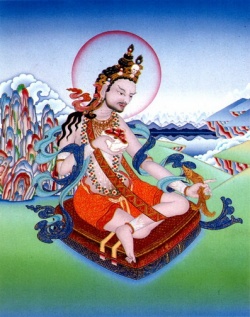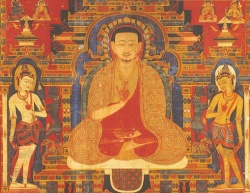Naro Choe Druk
The tradition known in Tibet as the Naro Choe Druk (Tib. Na ro'i chos drug) translates literally as "Naro's Six Doctrines," but has become better known to Western students of Tibetan Buddhism as "the Six Yogas of Naropa." Early scholars such as Dt Evans-Wentz, Prof. Herbert Guenther, and Garma C.C. Chang used this rendition in their translations and consequently established it as standard in the Western Buddhist world. Therefore I have followed their lead in using the term "Six Yogas," rather than "Six Doctrines," both in my earlier work and in the present compendium.
Over the centuries the manner in which the Six Yogas have been taught has varied with the different lines of transmission. Lama Jey Tsongkhapa discusses this in some depth in his longer commentary. There are also traditions of speaking of two, three, four, six, eight, and ten yogas of Naropa. However, these variations are merely different ways of dividing up the pie of the Naropa yogas; there are no substantial differences in what is taught.
To accommodate these differing modes of structuring the Naropa system, in both his longer and shorter treatises Lama Jey Tsongkhapa uses a somewhat complex system of outlines and headings. He does not simply present the six yogas in six chapters, but instead weaves a subtle line of thought that flows through his entire presentation. This makes his two treatises somewhat more difficult to follow than many of the simpler manuals on the system, but accommodates very accurately the flexible nature of the tradition and reflects the arbitrariness of calling it the "Six Yogas."
Later Gelukpa commentaries generally follow Tsongkhapa's lead in this respect. They rarely treat the Six Yogas in six chapters.
THE BACKGROUND AND NATURE OF THE PRACTICE
The Geluk school, which was formed in the early fifteenth century as a fusion of lineages from a dozen earlier sects, received its transmission of the Six Yogas primarily from the Zhalu (Sakya) school. The Zhalu had received it from the Drikung Kargyu (one of the Eight Younger Kargyu schools), which in turn is a derivative of the Pakmo Drupa Kargyu (one of the Four Older Kargyu schools). The Geluk lineage presents the Six Yogas in accordance with the way they were transmitted by Lama Pal Pakmo Drupa, the founder of the Pakmo Drupa school, to Lama Drikung Jigten Sumgon, the founder of the Drikung Kargyu school.
According to Lama Pal Pakmo Drupa's lineage the six yogas are listed as follows: inner heat yoga; illusory body yoga; clear light yoga; the yoga for the transference of consciousness to a higher realm; the yoga for transference of consciousness into another body; and the bardo yoga.
In this arrangement of the six, the inner heat is the foundation of all the yogas; the illusory body and clear light yogas are grouped together as the actual or principal practices for inducing the experience of enlightenment; and the yogas of consciousness transference to a higher realm and transference into another body are auxiliary or branch applications. This accounts for five of the six; the sixth, or bardo yoga, is regarded as both a branch of the illusory body yoga and as a third auxiliary practice.
In other words, the first three yogas-inner heat, illusory body and clear light-are the real methods for accomplishing enlightenment in one lifetime. The last three yogas-consciousness transference to a higher realm, transference into another body, and the bardo yoga- are only required if one fails to accomplish enlightenment before death draws near, and a forceful last-minute method of self-protection is required. The First Panchen Lama puts it as follows in his The Golden Key:

